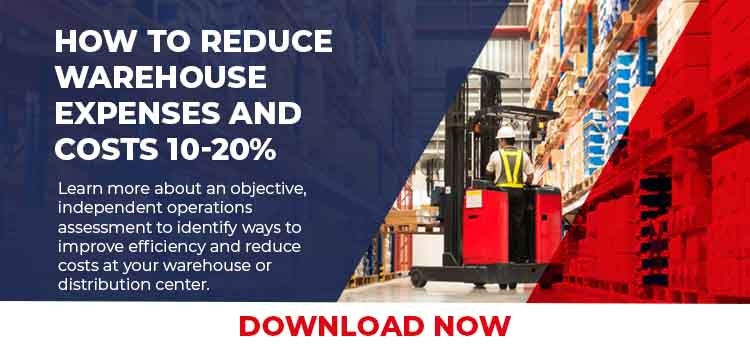In today's challenging and competitive world, your success can hinge on whether your warehouse operations are productive and effective enough to meet customer expectations.
One way to gauge how effectively your warehouse operations meet those expectations is to conduct a warehouse operations assessment. 
A warehouse operations assessment, also known as a fulfillment center audit, is a systematic review of all warehouse functions and possible efficiency and service improvements. Keep in mind, that if you cannot measure something, it is difficult - if not impossible - to improve it.
A warehouse operations assessment should include the following:
- Current systems and how well they support your current and future needs.
- The flow of goods and workers through each function within your operations.
- How you use material handling equipment (MHE) and what changes to consider.
- Productivity reporting by process and measurement against goals.
- How well you are servicing the customer against the stated goals.
- A measure of the current warehouse space capacity and utilization.
The benefits of performing an operational assessment include
- Improved productivity in various departments or functions.
- More effective use of space within your distribution center.
- Improved throughput and efficiency for order fulfillment and returns processing.
- Improved inventory accuracy.
- Reduced travel times, touchpoints, and bottlenecks in the operations
This article identifies how to conduct a warehouse assessment and provides resources to improve your operations. Once you gather the information, develop options and draft an action plan based on cost/benefit.
Five Steps to Performing an Assessment
The assessment process enables you to identify areas where you can improve operational performance to increase customer satisfaction and save money.
These five steps include:
- Walk-through and observations of the operation
- Data gathering of necessary information and metrics
- Interviews with key staff members
- Report analysis to determine current productivity and service levels
- External benchmarking to look for areas of potential improvement
1 - Walk-through
One of the first steps in the assessment is to walk through the fulfillment center and observe the effectiveness of current processes and general operating conditions.
Things to observe include:
- The general cleanliness of the warehouse
- Employee attitude and morale
- Overall work pace
- Information posting for employees
- Congestion
- Appropriate use of automation
- Bar code applications
- Space and cube utilization
This walk-through is not a detailed analysis but an opportunity to develop an overall impression of the warehouse space that will guide the direction of the assessment.
2 - Data Gathering
The assessment will involve some new research, but chances are you've already collected much of the data for other purposes. Designing an assessment is a matter of putting it all together. Most assessments combine research analysis, report review, and on-site fact-finding.
Establishing expectations, or standards, is always necessary as the baseline for any comparison. Measurement against these standards identifies areas where expectations are not met, and action is required.
You will want to gather all your existing research and collect any missing information.

3 - Staff Interviews
Another critical step is to talk to those staff members directly involved in the assessed activity.
Interview key management staff to gauge their perspective on the operation and any plans for growth, product changes, or planned process changes.
Next, talk to the workers on the floor doing the work in the facility. If anyone knows where problems and opportunities lie, it is the people who live with the issues day in and day out. Do not miss this vital resource; they are often the best information source.
4 - Report Analysis
While there are many reports you could analyze, we recommend the following as the most critical:
- Basic internal operations performance - this report includes service levels such as order shipping accuracy and turnaround time
- Receiving
- Quality assurance
- Stock put away
- Returns
- Inventory management
- Replenishment
- Order picking, packing and shipping
Examining these reports can help reveal which departments are reaching desired levels of warehouse efficiency and which need some attention.
The reports will usually include information on budgets or expectations compared to results in key business areas, covering productivity and service metrics.
5 - Benchmarking
One of the best ways to measure improvement in your fulfillment center efficiency is to track and compare performance against yourself over time.
Your assessment should compare your desired service and productivity standards with your actual performance.
Once you have a solid understanding of internal performance and how you measure up to your own operational goals, you can then selectively choose external benchmarks and other companies to compare them to
When choosing fulfillment centers to compare yours to, pick ones similar to yours. They should calculate metrics the same way; otherwise, the comparison could be meaningless.
The purpose of comparing your operations to other fulfillment centers is to reveal areas or processes within your operation that could be studied further.
But, we believe it is always better to compare your results against yourself and a set of standards or expectations over an established period. This permits the identification of trends as well as snapshot evaluations.

Remember, there are too many operating differences to take someone else's standards or performance expectations and make them your own.
It is also vital to make sure you measure activities and costs that are relevant and actionable.
Reviewing accurate productivity metrics regarding work units and person-hours is better than looking at a percent to sales measure. The percent measure is dramatically affected by price points and labor market conditions, which are usually out of your control.
Emphasis should be on comparable benchmarks that can lead to action steps by the operations group.
Metrics commonly found in a warehouse benchmark assessment include:
- Total warehouse cost per order/line/unit (includes direct labor, indirect labor, occupancy costs, and packaging)
- Units per person-hour for receiving, putaway and replenishment
- Picking units and lines per person-hour
- Boxes per person-hour for packing and shipping
- Outbound shipping costs
- Orders and net sales per square foot of warehouse space
- Orders per full-time equivalent (FTE)
- Average base pay
- Cost factors as a % of net sales
- Customer service level, including order turnaround time, as well as order and inventory accuracy
- Percent utilization of available warehouse space
- Seasonality - % of business by quarter
Four Critical Areas in a Warehouse Assessment
There are four critical areas to assess in any fulfillment center audit. These areas make up the essential aspects of any fulfillment operation.
They are:
- Labor
- Facilities
- Workflow and procedures
- Systems
Labor
Labor is typically the most expensive area on your profit and loss statement relating to fulfillment costs, and it's important to get the most from your payroll dollar.
Labor consists of four areas. The first two can be easily quantified; the others are more difficult to quantify but should be included in your assessment
Productivity
Productivity is simply a measure of the number of work units processed in a given time, either by an employee or department.
Work units can be anything associated with fulfillment functions such as order processing, packing and shipping, and lines.
Cost of labor
Direct labor is the part of your labor force directly involved in physically moving inventory, and indirect labor includes clerical workers, managers, supervisors, administrative staff, security, and more.
The relationship between labor cost and productivity is critical to understanding where to place your emphasis. Therefore, your warehouse assessment should include both areas of labor.
Turnover and training
The effect of your employee turnover rate is difficult to quantify, but rest assured, it is real. And a simple calculation can help determine how often your workforce changes.
A high turnover of workers negatively impacts productivity as new employees work through the learning curve to reach complete competence.
In addition, the cost of hiring—screening, drug testing, and training is escalating.
By contrast, a stable workforce that knows the system and processes can continually work toward new efficiencies.
Ask yourself what you can do to reduce the turnover rate. How efficient is your training process? Are training procedures documented? Are there enough training materials and manuals on hand? All these factors will make a difference in the effectiveness of your training efforts.
Local labor market

Your local labor pool will affect productivity and costs in a way that is hard to measure.
A low unemployment rate may mean that you’ll have to pay higher wages to attract quality workers who can achieve your desired productivity levels. This will invariably increase labor costs, which are already a hefty chunk of warehouse operating costs
A high unemployment rate can have the opposite effect. The local economy is largely beyond your control yet it can profoundly influence your operations. All the more reason to manage your warehouse labor to reduce overall expenses.
Facilities
During your assessment, you should examine facilities to determine your warehouse layout design efficiency.
Components of a facilities assessment include:
The Cube
Focus cube utilization on inventory storage and picking and packing as these areas combined typically account for 70-80% of warehouse space.
Are you using the whole "cube" (square footage and height) effectively?
Assessing this space will offer insights into how to maximize the area before spending money and effort to add resources. Any expenditures to improve the cube will be justified and generate an accurate return on investment (ROI).
Costs
Occupancy costs (lease or depreciation costs of building and equipment, utilities, maintenance, taxes, and insurance) typically amount to 18-22% of the total fulfillment center costs.
Beyond that, there are many ways to map your facility's costs and compare the results to other companies, such as calculating the occupancy cost per order or call.
Seasonality
Your warehouse will operate differently in peak and off-peak seasons. In fact, the frenetic activity of peak season is a good time for an assessment to see whether your warehouse space is sufficient and your systems hold up.
Whenever you perform your assessment, keep peak-season needs in mind.
Housekeeping/Maintenance
Cost of occupancy increases as housekeeping standards decrease. Things like congestion, inadequate lighting, poor inventory storage, and a lack of proper maintenance will slow work and put your workforce at risk of costly accidents that drain profits.
Dirty conditions can affect products, resulting in costly returns, and adversely affect the operation of barcoding equipment, automated conveyances, and mechanical sorting devices.
Besides, your workforce's attitude, productivity, morale, and retention will be higher in a tidy workplace.
Workflow and Procedures
Workflow and procedures are often the most straightforward areas to improve fulfillment costs.
Your goal is to minimize the number of times a product is handled and the steps your crew must take to move it through the fulfillment center. Providing the potential to match future needs with improved fulfillment operations is critical.
Flow Charts
Develop a chart detailing how products move from receiving and returns to replenishment. And a second one that shows how orders move from pick ticket generation to shipment. As you trace the movement of goods, notice how the current layout helps or hinders workflow.
These flow charts will point to any contradictions in departmental workflows. Whether you are using conveyors where you should, employing suitable material handling equipment, and if you're storing inventory appropriately.
Work paths should minimize travel time and merchandise movement. And departments should be situated logically in relation to one another to reduce travel between them.
Slotting Systems
Your slotting program determines order picking efficiency. The goal is to have products available when the picker reaches the pick slot and also manage the number of replenishments needed.
The ideal slotting system provides flexibility with inventory management. You should re-profile your primary pick slots as part of a dynamic, ongoing process.
Packaging Materials
Failure to keep enough materials at each workstation for employees to do their jobs (e.g., shipping cartons, dunnage, gift wrap, taping, picking tote boxes, etc.) will mean productivity suffers while workers lose valuable time gathering materials or waiting for them to be delivered.
Quality Control
Don't rely on customer returns to gauge your accuracy or quality performance. An undetected error typically costs $25 to $50 and identifying errors will save money.
Ensure you are measuring and reporting internal quality checks and taking action as needed. The assessment should review both incoming and outgoing quality. Ongoing review of vendor compliance manuals should also be part of quality control.
Systems
Warehouse management systems benefit warehouse efficiency as they provide the functionality and flexibility you need and support efforts to maximize space and labor effectively.

Basic warehouse management system (WMS) functionality should include.
Inventory Management
Inventory management is the most critical WMS function. It should track products by SKU, quantity, location, and transactions against the location and ensure inventory accuracy.
Barcoding
Not only will bar coding significantly improve the accuracy of inventory transactions, but it will also help you track productivity in four-walls inventory tracking (receiving, stock put away, pick, pack and ship) and productivity by individual activity and/or department. Proper barcoding can dramatically reduce paperwork.
Replenishment
Your WMS should control the bulk-to-forward movement of goods through minimum and maximum inventory triggers. It should also monitor demand quantity in waves of pick tickets to make sure sufficient quantities are in the forward pick location. Look for opportunities to cross-dock backorders.
Pick Ticket Selection
The WMS should enable you to print and sort pick tickets in various ways, depending on order priorities and resources available.
Pack Verification
You should be able to scan items for accuracy before you ship orders.
Tracking
Your WMS should track orders throughout the order fulfillment process and integrate order status into your customer service department.
Returns
Your WMS should minimize steps for processing returns to keep costs low.
All systems must communicate as needed and use shared data as much as possible to maximize operations efficiency and productivity.
Final Steps: From Assessment to Action
Once you've gathered and analyzed all the information you can, patterns will emerge, and you'll have a quantifiable picture of what you do well and what needs to be improved.
But your assessment isn't over.
The final step—the action plan—is what will make your assessment yield meaningful results
When creating your plan, focus on areas that will yield the most significant benefit. Before you tally up a long list of changes that will leave your team feeling overwhelmed, recall that Pareto's 80/20 Law usually works. To start, consider where you can get the biggest improvements from the smallest number of changes
Finally, write your action plan to provide continual improvements over time. It should include detailed action steps, assignment of accountability, and expected completion dates.
Manageable changes introduced gradually will be more effective and readily accepted by your workforce than one massive overhaul. Gradual change will make continual improvement a part of your corporate culture.
Don't assume that one operational assessment is enough.
You should conduct ongoing comprehensive assessments to stay in touch with customer needs, accommodate your company's growth, keep pace with your competition's improvements, and whatever promises your marketing department dreams up.
How FCBCO Can Help Your Fulfillment Center
Curtis Barry & Company has been helping warehouse owners improve operations with industry best practices since 1984.
When you are busy working in your business, it’s often hard to see the forest for the trees. And it’s easy to put off an assessment until things are out of control and you have big problems that need fixing.
Our approach to managing warehouse assessments has helped countless clients boost efficiency and productivity while lowering operating costs and expenses.
Don’t delay your much-needed warehouse assessment. Book a free consultation with us now.








SHARE